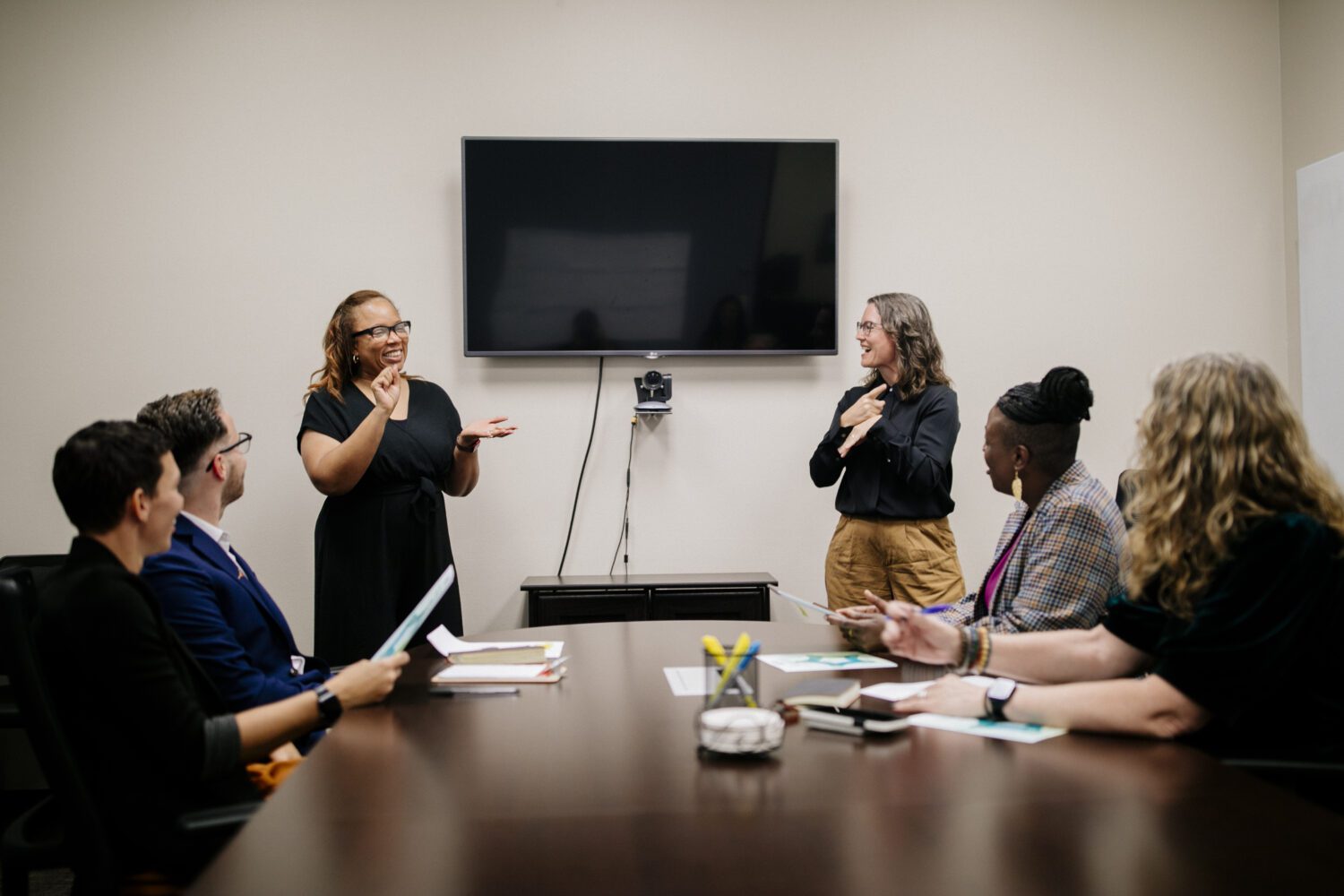Researchers from the National Deaf Center on Postsecondary Outcomes (NDC) were originally scheduled to make seven presentations — the most ever at a conference by NDC staff — at the American Educational Research Association (AERA) 2020 Annual Meeting on April 17-21, the world’s largest gathering of education researchers and a showcase for innovative studies. Because the conference was cancelled due to the COVID-19 pandemic, the papers and presentations will be uploaded to the AERA Online Repository to expand their impact, discoverability, and authentication.
NDC is funded by the U.S. Department of Education’s Office of Special Education Programs (OSEP) and Rehabilitation Services Administration (RSA). It is housed at the University of Texas at Austin’s College of Education.
NDC’s AERA 2020 presentations, which focused on improving postsecondary outcomes for deaf youth, were in the following session topic areas: deaf and hard of hearing intersectionalities, marginalized student groups, college persistence, multiculturalism and youth development, and postsecondary access and success for students with disabilities.
Staff contributors included:
-
Stephanie W. Cawthon, PhD, Director of NDC and Professor at the University of Texas at Austin College of Education
-
Carrie Lou Garberoglio, PhD, Associate Director, NDC
-
Jeffrey Levi Palmer, PhD, Research Associate, NDC
-
Diego H. Guerra, Community Engagement Coordinator, NDC
Six of the presentations included graduate research assistants at NDC, who are all doctoral students at the University of Texas of Austin, reflecting the center’s commitment to mentoring:
-
Genelle T. Sanders, MA
Three of the presentations were in collaboration with researchers from SRI International, including Lynn Newman and Debra Shaver, in a partnership to reduce barriers and optimize outcomes for students.
In addition to the presentations, Dr. Cawthon also planned to participate in a private panel of Review of Research in Education (RRE) chapter authors and the RRE editorial team, to address “Evidence Based Practices or Best Available Evidence: Supporting Education Outcomes for Deaf Students,” the chapter she is co-authoring with Dr. Garberoglio for the 2021 edition of the book.
NDC’s presentations at AERA 2020:
Measuring Accessibility of Postsecondary Education for Deaf Individuals | A roundtable paper session presentation by Savannah Davidson, Jeffrey Levi Palmer, and Stephanie W. Cawthon. Equal access to postsecondary education is a basic legal right protected by the Americans with Disabilities Act and its amendments, yet not all deaf people have an equal opportunity to access. Furthermore, the accommodations-based approach to accessibility “retrofits” access onto an inaccessible system. A self-report online survey of deaf students about the accessibility of their postsecondary education environments indicate low ratings for institutional accessibility. The call is for institutions to consider a range of strategies for meeting the needs of deaf and diverse students, using a framework with six domains: attitudes, communication, campus technology, environment, services, and social engagement.
Expectations and Transition Planning Goals as Predictors of Postsecondary Educational Enrollment of Deaf Youth | A symposium session by Paige M. Johnson and Stephanie W. Cawthon. The findings, which were co-authored with Lynn Newman and Debra Shaver at SRI International, suggest that—while parents and transition planning play roles in predicting postsecondary education enrollment—a deaf youth’s expectations of their own future educational pursuits may play a larger role in determining such outcomes. For deaf students, raising expectations, providing opportunities for rigorous course preparation, and ensuring they have role models for learning how to navigate the complex hearing postsecondary environment—known as vicarious experiences—are all malleable factors that may strengthen the transition experience.
Employment and Community Engagement Outcomes for Deaf Individuals after College | A roundtable paper session by Jeffrey Levi Palmer and Savannah Davidson. Using the National Longitudinal Transition Study-2 (NTLS2) data set and co-authored with its principal investigator, Lynn Newman at SRI International, this study explores the employment and social outcomes of deaf people by comparing three distinct groups: those who never attended college, those who attended and did not graduate, and college graduates. A significantly higher percentage of graduates reported employment, civic engagement, community service, and voter registration compared to the other two groups. It illuminates how systemic barriers differentially affect young deaf adults based on their postsecondary status and illustrates how other postsecondary programs—including training and technical education—can also strengthen outcomes for young adults.
Self-Advocacy and Social Skills Training as Predictors for Social and Community Engagement of Deaf Adults | A poster session by Claire Ryan and Carrie Lou Garberoglio. This study, which was co-authored with Lynn Newman and Debra Shaver at SRI International, finds that deaf youth who received self-advocacy training during high school had ten times greater odds of social engagement as young adults than those who did not receive such training. Compared to social skills training, self-advocacy interventions may target and strengthen personal agency, foster a sense of belonging, and empower deaf students to apply their skills to become active community participants.
Community-Based Strategies for Strengthening Postsecondary Outcomes for Deaf People | A roundtable session by Carrie Lou Garberoglio, Diego Guerra, and Genelle T. Sanders. Community conversations allow space for community members to engage in strategic decision-making about issues that impact their lives, and is particularly valuable for marginalized populations like the deaf community. This analysis of data generated in community conversations across the nation indicated that communities prioritized system change strategies that center deaf youth like building more robust support systems and strengthening youth skills.
Standby to Standby: Postsecondary Attainment & Persistence of Veterans with Hearing Difficulties | A roundtable paper presentation by Jeffrey Levi Palmer. Using U.S. Census data to calculate the graduation rate of veterans with hearing difficulties, Dr. Palmer and co-author Adam Sales from the University of Texas at Austin found that veterans with hearing difficulties enroll in college as often as their peers, but are less likely to earn a degree. This suggests veterans with hearing difficulties are not receiving the necessary accommodations and support to succeed at college.
Predictors of Developmental Course-Taking Among Deaf College Students | A paper session by Carrie Lou Garberoglio and Bita Razavi-Maleki. Many college students are placed in developmental (or remedial) courses, with higher enrollment rates among deaf students. This analysis of data from the National Postsecondary Student Aid Study demonstrated that deaf college students who take college-level courses during high school are less likely to enroll in developmental courses in college, and that deaf college students in associate’s degree programs were more likely to enroll in developmental courses than those in bachelor’s degree programs.. These findings indicate that high schools should increase opportunities for college-level course-taking among deaf students to strengthen college readiness and that associate’s degree programs need to be prepared for higher placement in developmental education among their deaf students.
For a complete list of conferences that NDC is participating in or presenting at, please visit the Conferences section of this website.









